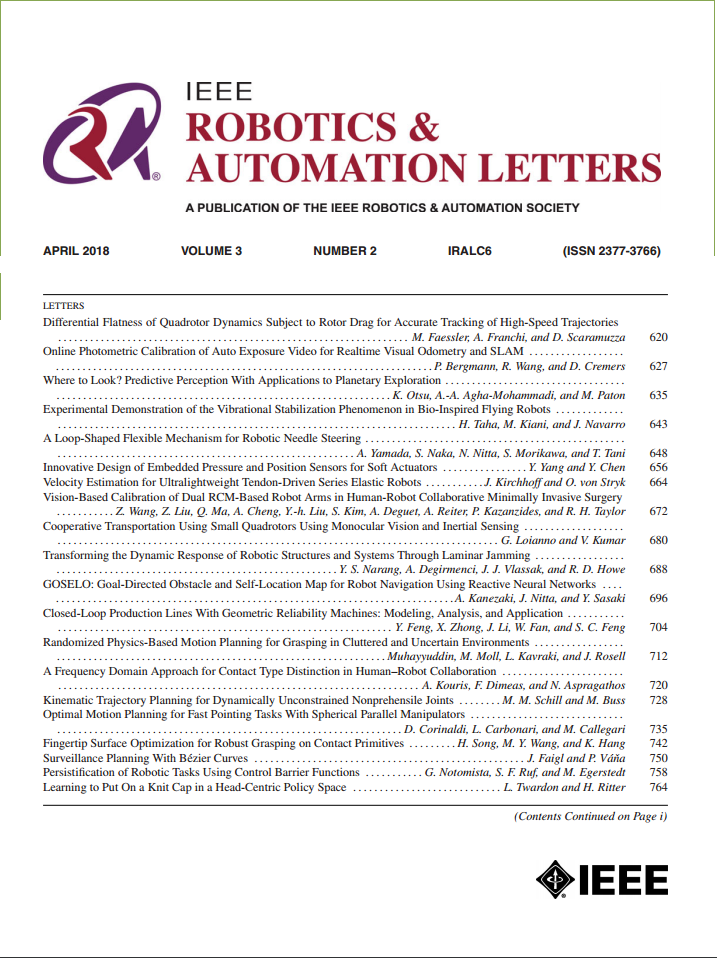Intraoperative Tumor Localization Using Sweeping Palpation in Robot-Assisted Minimally Invasive Surgery (RMIS)
IF 5.3
2区 计算机科学
Q2 ROBOTICS
引用次数: 0
Abstract
Robot-assisted minimally invasive surgery (RMIS) provides superior visualization, precision, and flexibility, and it has gained recognition as a technology that enhances therapeutic outcomes, particularly in tumor resection. However, this technology has a limitation in that it predominantly relies on visual feedback, making it challenging for surgeons to accurately detect the location and edges of tumors during surgery. To address this issue, robotic palpation methods have been actively studied. Among these, the sweeping palpation method has the advantage of rapidly exploring a broad region. Nevertheless, conventional sweeping palpation methods can only roughly identify the tumor's location and are limited in detecting tumor edges with precision. In this study, we introduce a novel sweeping palpation method to overcome the limitations of conventional sweeping palpation in RMIS and propose a precise tumor localization method based on this approach. The proposed method involves performing sweeping palpation on the tissue surface using the tip of the robotic end effector while utilizing a Laplacian edge detection algorithm to detect abrupt changes in contact force. This method reduces the reliance on preoperative imaging and enables tumor localization to be performed within a single robotic system. To validate the proposed tumor localization method, we conducted three phantom experiments and机器人辅助微创手术(RMIS)中扫描触诊术中肿瘤定位
机器人辅助微创手术(RMIS)提供了优越的可视化、精度和灵活性,并且作为一种提高治疗效果的技术,特别是在肿瘤切除方面,已经得到了认可。然而,这项技术的局限性在于它主要依赖于视觉反馈,这使得外科医生在手术过程中准确检测肿瘤的位置和边缘具有挑战性。为了解决这个问题,机器人触诊方法已经得到了积极的研究。其中,扫描触诊法具有快速探查范围广的优点。然而,传统的扫描触诊方法只能粗略地识别肿瘤的位置,并且在精确检测肿瘤边缘方面受到限制。在这项研究中,我们引入了一种新的扫描触诊方法,克服了传统的扫描触诊在RMIS中的局限性,并提出了一种基于该方法的精确肿瘤定位方法。所提出的方法包括使用机器人末端执行器的尖端对组织表面进行扫描触诊,同时利用拉普拉斯边缘检测算法来检测接触力的突变。这种方法减少了对术前成像的依赖,使肿瘤定位能够在单个机器人系统中进行。为了验证所提出的肿瘤定位方法,我们进行了三个幻影实验和离体实验。这些验证证明了我们提出的方法在精确肿瘤切除和建立有效治疗计划方面的潜力。
本文章由计算机程序翻译,如有差异,请以英文原文为准。
求助全文
约1分钟内获得全文
求助全文
来源期刊

IEEE Robotics and Automation Letters
Computer Science-Computer Science Applications
CiteScore
9.60
自引率
15.40%
发文量
1428
期刊介绍:
The scope of this journal is to publish peer-reviewed articles that provide a timely and concise account of innovative research ideas and application results, reporting significant theoretical findings and application case studies in areas of robotics and automation.
 求助内容:
求助内容: 应助结果提醒方式:
应助结果提醒方式:


